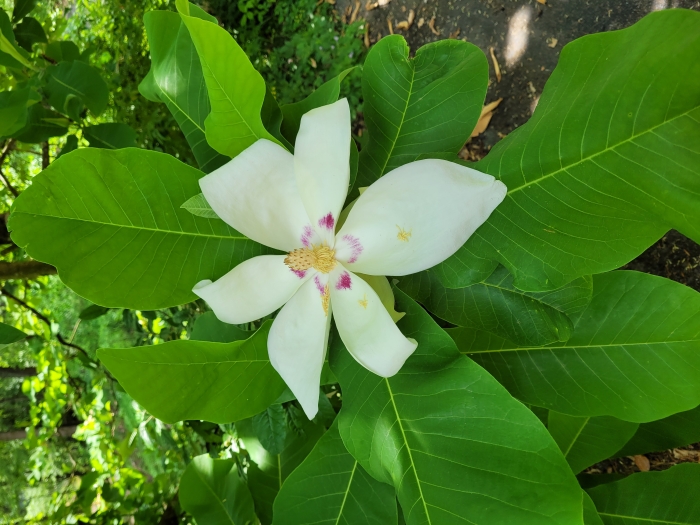Bigleaf Magnolia
(Magnolia macrophylla)
Bigleaf Magnolia (Magnolia macrophylla)
/
/

Nisuaz
CC BY 4.0
Image By:
Nisuaz
Recorded By:
Copyright:
CC BY 4.0
Copyright Notice:
Photo by: Nisuaz | License Type: CC BY 4.0 | License URL: https://creativecommons.org/licenses/by/4.0 | Uploader: Nisuaz | Publisher: Wikimedia Commons | Title: Magnolia_macrophylla_(Bigleaf_Magnolia).jpg | Notes: Transferred from Flickr via #flickr2commons |













































































Estimated Native Range
Summary
Magnolia macrophylla, commonly known as Bigleaf Magnolia, is a deciduous tree native to rich, moist, well-drained soils in the understory of deciduous forests of the Southeastern United States. This medium-sized tree typically grows 15–20 meters tall and is notable for its enormous leaves, which are among the largest of any temperate plant, measuring 25–80 cm in length and 11–30 cm in width. The branches may bend under the weight of the foliage. The flowers, which bloom in late spring to early summer, are exceptionally large and showy, up to 41 cm wide, with some reaching 55 cm. They are creamy white with a distinctive purple blotch at the base and are beetle-pollinated.
The Bigleaf Magnolia is valued for its impressive foliage and the largest flowers of any native North American tree. It is used as a specimen tree in large gardens and parks. It requires a sheltered location to protect its large leaves from wind damage. While it prefers full sun to part shade, it thrives in moist, acidic, well-drained soils rich in organic matter. It is generally free from serious pests and diseases. Due to its specific habitat requirements, it may be short-lived if not provided with conditions similar to its natural forest understory environment.CC BY-SA 4.0
The Bigleaf Magnolia is valued for its impressive foliage and the largest flowers of any native North American tree. It is used as a specimen tree in large gardens and parks. It requires a sheltered location to protect its large leaves from wind damage. While it prefers full sun to part shade, it thrives in moist, acidic, well-drained soils rich in organic matter. It is generally free from serious pests and diseases. Due to its specific habitat requirements, it may be short-lived if not provided with conditions similar to its natural forest understory environment.CC BY-SA 4.0
Plant Description
- Plant Type: Tree
- Height: 30-40 feet
- Width: 30-40 feet
- Growth Rate: Slow
- Flower Color: Cream, White
- Flowering Season: Spring, Summer
- Leaf Retention: Deciduous
Growth Requirements
- Sun: Full Sun, Part Shade
- Water: Medium
- Drainage: Slow, Medium, Fast
Common Uses
Bee Garden, Bird Garden, Butterfly Garden, Deer Resistant, Fragrant, Showy Flowers
Natural Habitat
Rich, moist, well-drained soils in the understory of deciduous forests of the Southeastern United States
Other Names
Common Names: Big-Leaf Magnolia , Large-Leaf Cucumber-Tree , Umbrella-Tree , Storbladig Magnolia
Scientific Names: Magnolia macrophylla , Metamagnolia macrophylla
GBIF Accepted Name: Magnolia macrophylla Michx.